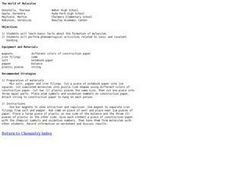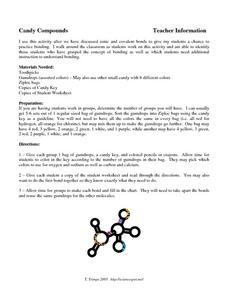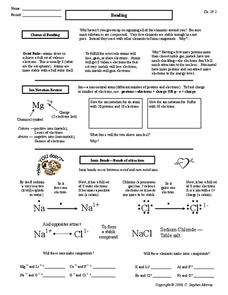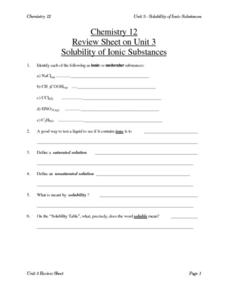Curated OER
How Do Atoms Stick Together?
In this chemical bonding activity, learners answer 10 questions about ionic bonding, covalent bonding, metallic bonding, Lewis structures, and intermolecular forces.
Curated OER
Electonegativity-How Do Atoms Stick Together?
In this electronegativity worksheet, students use given electronegativity values for each element to determine the bond type in 9 molecules.
Curated OER
Ion (Derstand) Bonding through Energy Level Diagrams
Ninth graders investigate ionic bonding through energy level diagrams. For this ion bonding lesson plan, 9th graders observe demonstrations to show energy level diagrams using magnets to represent the subatomic particles. Students fill...
Curated OER
The World of Molecules
Students investigate molecules through 2 demonstrations and writing formulas for molecules given the oxidation states of the atoms. In this molecules lesson plan, students observe iron filings being separated from salt and pepper using a...
Curated OER
Chemical Bonding
Students classify compounds as ionic or covalent. In this chemical bonding lesson plan, students experiment with 6 chemical compounds. They test physical properties such as the melting point, the solubility and the electrical...
Curated OER
Intermolecular Forces Worksheet
In this intermolecular forces worksheet, learners answer 4 questions about the forces between atoms within molecules and compounds. Students rank the boiling points of compounds based on their intermolecular forces and they explain...
Curated OER
Naming Compounds
In this naming compounds instructional activity, students are given a chart to determine if the compound they are naming is ionic, covalent or polyatomic. Students practice identifying and naming ionic, covalent and polyatomic compounds....
Curated OER
Bonding
In this bonding worksheet, high schoolers read about the octet rule in bonding, ion notation, ionic bonds, covalent bonds and oxidation numbers. Students write 2 ion notations, they determine if 8 sets of ions will make compounds, they...
Curated OER
Ionic Bonds
In this ionic bond activity, students read about the transfer of electrons from one atom to another in ionic bonds. They answer seven questions about sodium and chlorine and draw Bohr-Rutherford diagrams to show the bonding between these...
Curated OER
Candy Compounds
In this compounds worksheet, students are given a bag of colored gumdrops that represent specific atoms. They construct ionic and covalent bonds with gumdrops using the key provided and the compounds to build. They fill in a chart with...
Curated OER
Bonding Basics Review
In this bonding learning exercise, students complete a chart of elements, their symbols, the total number of electrons, the number of valence electrons and the oxidation numbers. They draw Lewis structures for atoms and show the transfer...
Curated OER
Worksheet-Bonding
For this bonding and electron configuration worksheet, students answer 9 multi-part questions including identifying the differences between bond types, drawing Lewis structures for atoms and identifying types of bonds in molecules.
Curated OER
Chemical Bonding and Shapes of Molecules
In this chemical bonds learning exercise, students review the different types of bonds, Lewis dot structures, ions, and molecule shapes. This learning exercise has 10 matching, 17 multiple choice, and 3 drawing questions.
Curated OER
Bonding
In this bonding learning exercise, students read about the two different types of chemical bonding: ionic and covalent bonds. Students review ion notation and oxidation numbers. This learning exercise has 24 fill in the blank, 2...
Curated OER
Naming and Covalent Compounds
In this compounds worksheet, students practice naming compounds and classifying them as ionic, covalent, or polyatomic compounds. This worksheet has 12 fill in the blank and 12 problems to solve.
Curated OER
Chemistry Chapters 8 & 9
In this chemistry learning exercise, students explain the difference between a covalent bond and an ionic bond. Then they write the Lewis symbol for the atoms and ions presented, such as carbon and sulfur. Then they predict whether the...
Curated OER
Common Ions and Their Charges
In this chemistry worksheet, students can use the table to observe and name the common types of ions and determine the charges to explain the gain or loss of electrons.
Curated OER
Of Electron Bondage
Students create models of ionic and covalent electronic bonds to demonstrate their understanding of these chemistry concepts. They explain how both ionic bonds and covalent bonds work so that younger students can understand.
Curated OER
Section 4.2: Ionic and Covalent Bonding
There are only six short answer questions on this assignment. Chemists explain electrical conduction properties of salt, salt water, and gold. They compare ionic and covalent bonds. The explain bond strengths. Perhaps you could use this...
Curated OER
How is the Strength of an Acid Determined?
Young scholars study acids and how they can be measured. In this acid lesson students distinguish the properties that create strong and weak electrolytes.
Curated OER
What Holds a Substance Together?
Students observe how substances are held together by bonds. In this physics lesson, students demonstrate how a substance is held together by ripping newspapers and stretching marshmallows. Students complete a data sheet.
Curated OER
Recognizing Polar Molecules
For this polar molecules worksheet, students complete a graphic organizer by writing in the bond type, electron dot diagram, and the type of compound for the chemical compounds given.
Curated OER
AP Chemistry Chapter 9
In this AP Chemistry worksheet, students apply concepts of electron configuration to accurately answer the questions provided. Students also draw Lewis structures of the given elements. Students estimate the enthalpy of formation as well...
Curated OER
Solubility of Ionic Substances
In this solubility worksheet, students identify substances as either ionic or molecular, define saturated solution and solubility, and calculate concentration of solutions. This worksheet has 7 short answer, 5 fill in the blank, and 27...

























